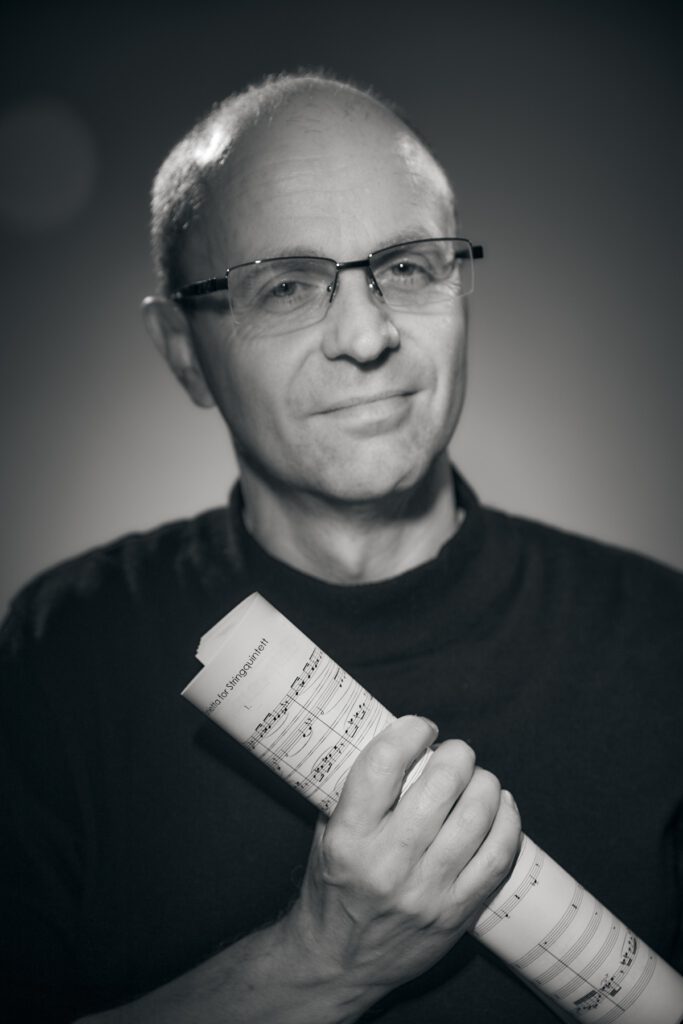Welcome
I’m Martin Lotz, a contemporary music composer. I am working at the intersection of tradition and innovation. My music explores free tonality, formal clarity, and expressive nuance. Often moving between restrained stillness and intense dynamic expression. I am particularly drawn to composing for orchestra and chamber ensembles, where sound can breathe and transform across time and silence.
Working outside formal academic structures, I have developed my compositional voice autodidactically. Grounded in deep listening and a personal search for sound. My aesthetic is shaped by a fascination with structure, gradual transitions, and harmonic depth. Rather than relying on surface gestures or showmanship, I seek to create music that invites thoughtful interpretation and inner resonance.
→ Explore my music | → Read about my approach | → Contact
In 2022, my string quintet Disput was performed at the MozArte Festival in Aachen under the artistic direction of pianist Andreas Frölich. Recent works such as the Piano Concerto Op. 9 Vers le silence and the Piano Trio Op. 8 reflect my approach to reimagining classical forms through contemporary language:
- modular and evolving structures
- ambiguous tonality with modal and chromatic shifts
- subtle rhythmic layering and expressive restraint
My compositions often develop from quiet tension rather than obvious climaxes. They are designed for performers who value nuance, intimacy, and slow musical unfolding – and for listeners who engage deeply with sound and silence.
What’s New
- New Violin Concerto – Current Stage of Composition
- Vers le silence – a 16-minute concerto for piano and orchestra (2025)
- Piano Trio Op. 8 – composed in 2023 for violin, cello and piano
- Sinfonietta “Disput” – performed at the 2022 MozArte Festival (see Youtube-video), Concerto Élégiaque – for violin, cello and string ensemble and Quasi una sonata – for 12-player chamber ensemble
For details, full scores, or to explore my works, please visit the Works page. Audio previews and downloadable excerpts are available.
New Violin Concerto | Current Stage of Composition
This video presents an excerpt from my current work Op. 10 – Violin Concerto. It represents the present stage of the composition, based on the orchestral score and audio rendering. The piece is rooted in a personal phase of reflection and reorientation — musically exploring stability, motion, and release. While the orchestration and dynamics are still evolving, the essential structure and sound world are already in place. Instrumentation: Solo Violin and Orchestra Duration (excerpt): approx. 6 minutes Feedback and impressions are welcome. (Audio rendering from the score, October 2025)
Piano Concerto Vers le silence
My new contemporary composition Vers le silence is a concerto for piano and orchestra with a duration of approximately 16 minutes. Rather than following the traditional three-movement concerto form, the work unfolds as a through-composed structure. Evolving organically across seven fluid sections. These vary in texture and intensity, progressing from suspended sonic stillness through rhythmic densification to a quiet dissolution of sound.
The piece employs free tonality, occasionally gravitating toward tonal centers such as C minor or A minor. But it is never conforming to traditional functional harmony. Modal inflections, clusters, polyrhythms, and microtonal shades contribute to a nuanced and multi-dimensional sound language.
The piano does not act as a virtuoso protagonist in the conventional sense. But as a sensitive sound carrier – at times isolated, at times in close dialogue with the orchestra, and often merged with its sonic textures. The orchestration (a compact ensemble of flute, oboe, B♭ clarinet, B♭ trumpet, F horn, trombone, solo piano, and strings) remains transparent and responsive throughout, never overpowering.
The formal logic of the piece lies in its balance between motion and stillness. Between density and openness, linear development and eruptive moments. Silence plays a central structural and emotional role, not as absence but as active musical substance. The work does not build toward a climactic culmination, but rather turns inward – “vers le silence.”
This compositional approach calls for performers with a deep sensitivity to nuance, balance, and phrasing. Vers le silence is an invitation to explore listening as a poetic and expressive act, reaching beyond the notes themselves.
Piano Trio
In composing my Piano Trio, I set out to explore a sound world that unfolds freely. Without strict formal constraints- guided instead by the inner motion of texture, expression, and gesture. The piece is through-composed, evolving organically through shifts in tempo, atmosphere, and articulation rather than following a traditional multi-movement structure.
From the opening Grave, I wanted to create a space of reflection and sonic stillness. As the music progresses into Lento, Addagiette, and Adagio passages, I aim for a lyrical and meditative flow where each instrument carries both melodic and timbral significance. The vibrato indications, glissandi, and subtle dynamic shades are not decorative – they are essential tools for shaping colour and tension.
The harmonic language is freely tonal, often hovering in modal areas, and at times venturing into dense harmonic clusters. These sonorities are not meant to shock but to invite the listener into a space where harmony breathes and shifts like light through clouds. The piano alternates between resonance and rhythmic weight, while violin and cello engage in an intimate, often speech-like dialogue.
I see this trio not as a narrative, but as a landscape: one that moves slowly, occasionally surges forward, and often lingers in silence or resonance. It requires a deep sensitivity to time and listening among the performers. While the score is detailed, I hope it leaves room for interpretation – inviting each ensemble to shape the music anew. Martin Lotz, contemporary music composer.
Collaborations

I’m currently seeking collaborations with pianists, conductors, and ensembles interested in exploring new repertoire for concert performance, workshop, or recording. f this resonates with your artistic interests – let’s connect.
Martin Lotz – Contemporary Music Composer | Piano & Orchestral
